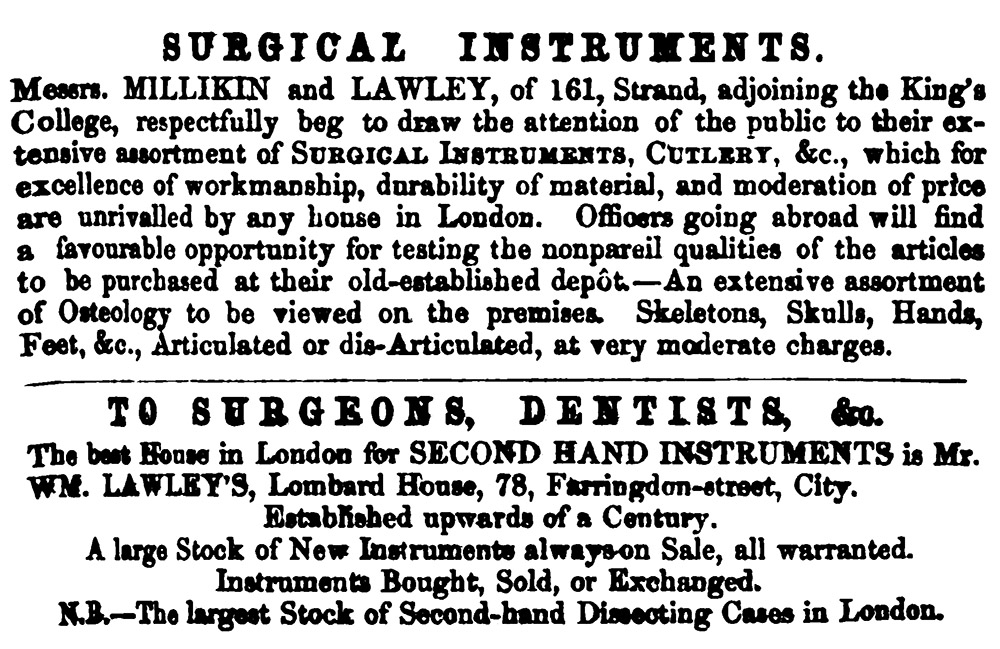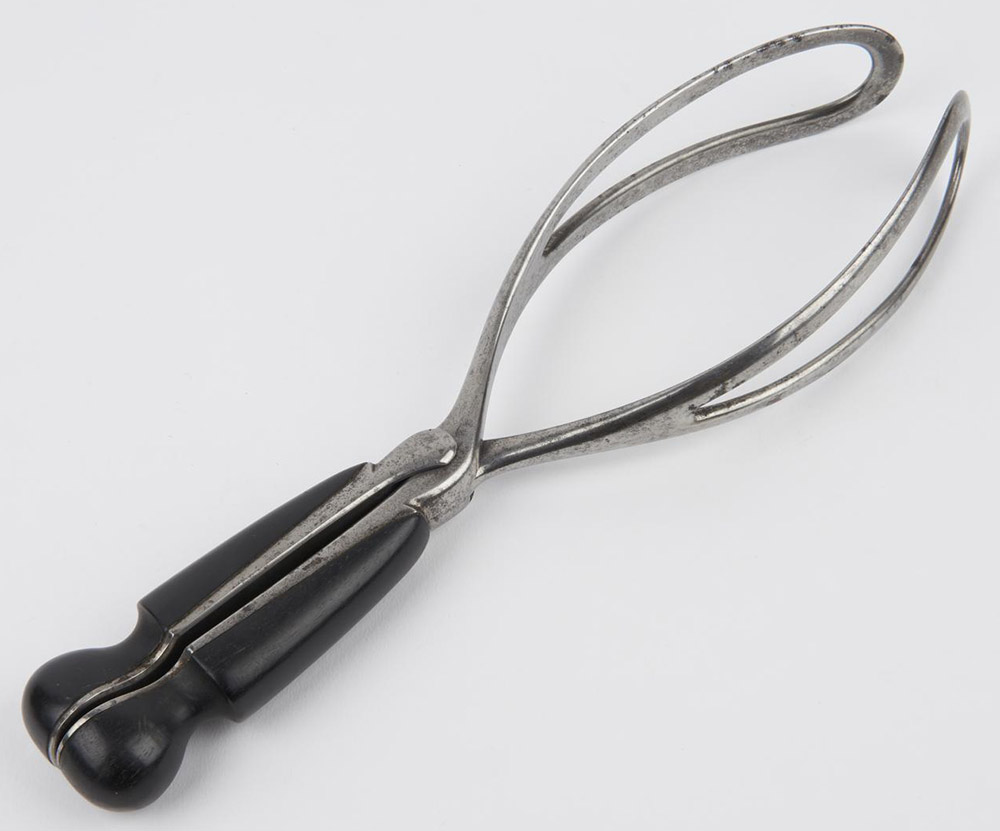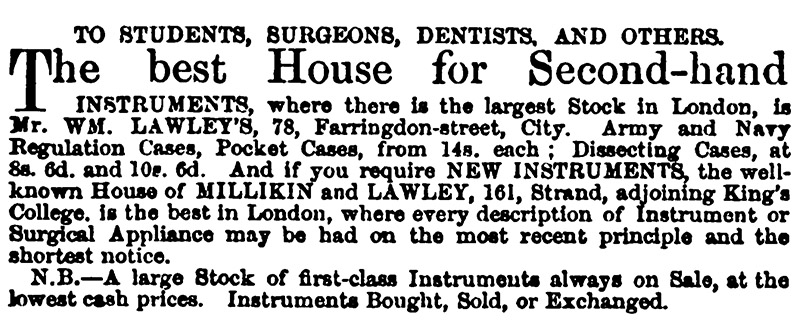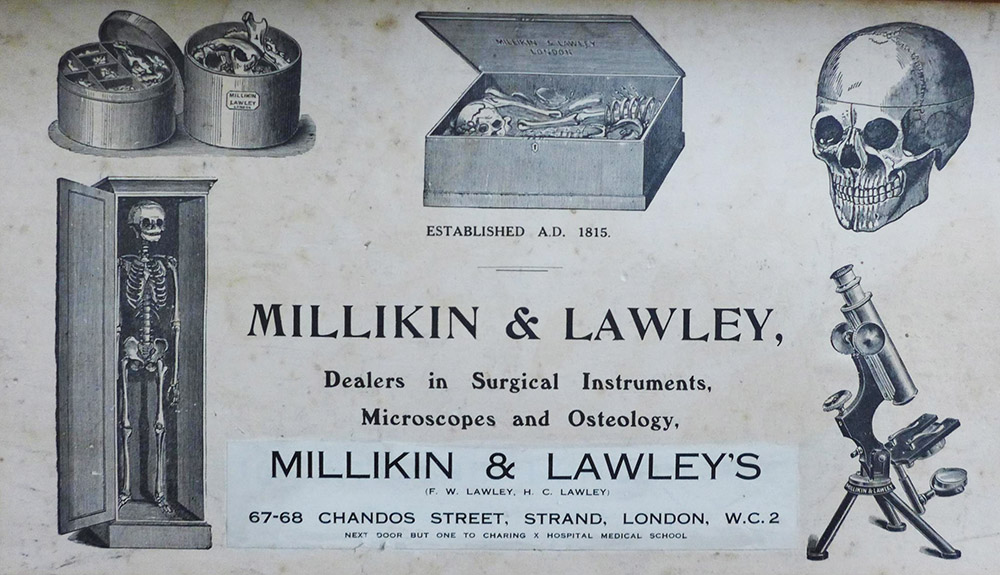Millikin and Lawley
and
William Lawley / Lawley & Son / Walter Lawley
John Millikin, ca. 1786 - 1833
Martha Millikin, 1794 - 1854
William Lawley, 1814 - 1899
Edwin William Lawley, 1843 - 1939
Walter Lawley, 1850 - ca. 1910
Frederick William Lawley, 1870 - 1952
Henry Crawford Lawley, 1872 - 1951
by Brian Stevenson
last updated August, 2023
These London businesses had their beginnings with the 1815 establishment by John Millikin of a surgical and cutlery business, and William Lawley’s opening of a pawnbroker’s shop circa 1842.
After John Millikin’s death, his widow, Martha, continued the medical supply business. After she died, it was purchased ca. 1859 by William Lawley. He renamed the Millikin business as “Millikin and Lawley”, while also continuing his pawn shop separately as “William Lawley”. Both shops sold microscopes of various descriptions, all of which appear to have been acquired from outside manufacturers. Many were produced by wholesalers, then labeled with the retailers’ names, while others were acquired second-hand and resold as used goods.
John Millikin’s shop was located at 301 Strand. Martha Millikin moved the shop to 161 Strand in about 1846. Surgical equipment and other apparatus that bear the name “Millikin” and address “Strand” can be reliably attributed to this pair. Millikin and Lawley relocated to 168 Strand in 1871, then to 165 Strand in 1873. During the 1930s, the business moved a final time, to 67-68 Chandos Street. Millikin and Lawley ended business during the mid-1900s.
The Lawley arm was located at 78 Farringdon Street. It became Lawley & Son around 1874, then Walter Lawley in about 1881. A second shop was opened for a brief period at 8 Coventry Street, between 1886 and 1889. The business ended in the early 1900s.
There was another, unconnected business in London named “John Millikin” during the mid-late 1800s, which also made surgical and medical equipment, and is also known to have retailed microscopes. There were no known business links between that Millikin and the subjects of this historical essay, although the names have led some writers to make false assumptions. The other John Millikin (ca. 1809 – 1871) operated his shop from 1859 until 1871 in the Southwark section of London, near St. Thomas’ and Guy’s Hospitals. That Millikin took over the businesses of Bigg & Son / Bigg & Millikin, and was succeeded by Millikin and Walters, which closed in 1887. An illustrated history of the other Millikin business can be read elsewhere on this site. Antique medical apparatus the bear the name “Millikin”, without an address, were very likely manufactured by this second John Millikin.

Figure 1.
A bar-limb microscope with a modified Crouch-foot, signed “Millikin and Lawley, 165 Strand”. That address dates its sale to after 1873. This pattern of microscope is known to have been sold by several different dealers. The foot is very similar to those used by C. Baker, while the body resembles contemporary microscopes by Swift & Son, but the whole does not match any model known to have been retailed by either of those manufacturers. It may have been produced by Baker or Swift exclusively for wholesale distribution. Adapted for nonprofit, educational purposes from an internet sale site.

Figure 2.
A microscope that is similar to that shown in Figure 1, retailed by Walter Lawley, 78 Farringdon Street. Lawley advertised this model in 1883 (see Figure 28). Note that the fine focus knob is located on the limb, where it presses against a lever that raises/lowers the objective lens, whereas that shown in Figure 1 has the fine focus wheel on the body tube. Adapted for nonprofit, educational purposes from an internet sale site.

Figure 3.
A bar-limb / “Society of Arts” microscope that is signed “Millikin and Lawley, 165 Strand”, dating it to after 1873. Adapted for nonprofit, educational purposes from an internet sale site.

Figure 4.
Signed “Millikin and Lawley, 165 Strand”, this microscope bears wide Crouch-foot like those used by Swift & Son. Sold after 1873. Adapted for nonprofit, educational purposes from an internet sale site.

Figure 5.
A circa 1870s “Model 3-A” microscope by Edmund Hartnack or Hartnack & Prażmowski, of Paris, France, with a label indicating sale by Millikin & Lawley, 165 Strand (after 1873). Adapted for nonprofit, educational purposes from an internet sale site.

Figure 6.
A bar-limb / “Society of Arts” microscope, signed “Lawley & Son, 7 Farringdon Street”. The signature dates its sale to between ca. 1874 and ca. 1881. Adapted by permission from https://www.lecompendium.com/dossier_optique_46_microscope_lawley/microscope_lawley.htm

Figure 7.
A Crouch-footed microscope that is signed “Walter Lawley, 8 Coventry Street & 78 Farringdon Street”. Lawley operated a second shop on Coventry Street from 1886 until 1889. Adapted for nonprofit, educational purposes from an internet sale site.

Figure 8.
A post-1873 trade label from Millikin & Lawley, stating that the business was founded in 1815.
John Millikin: The April 28, 1833 record of John Millikin’s burial states that he had died when 47 years old, indicating birth circa 1786. His origins are uncertain. However, another man named John Millikin opened a cutler’s business in Dublin Ireland in 1787, similarities in names and occupations that suggest a relationship between the two men - possibly even father and son. Regarding the elder Millikin, The Dublin Evening Post reported on March 31, 1787: “Cutlery Manufactory. John Millikin, No. 17, College Green, Dublin, who served his apprenticeship, and was employed thirteen years at Mr. Read’s shop in Parliament Street, particularly in manufacturing Razors and Lancets, respectfully informs the Nobility and Gentry that he has removed from No. 6 Church Lane to No. 17 College Green, Dublin, opposite King William, where he carries on said business in the best manner. The peculiar excellence of his Razors so universally admired under the name of another, sufficiently recommends them. Table knives, Pen knives, scissors, etc. of the newest station and best material. On the cheapest and superior quality of his goods, he rest his hopes of success. Old Work repaired with care and expedition. An apprentice wanted”. That Millikin, or a successor, remained in business in Dublin until at least 1845.
As noted above, a second man named John Millikin (ca. 1809 – 1871) manufactured and sold cutlery and surgical equipment in London between 1859 and 1871. Census records indicate that the second John Millikin was Irish, suggesting that there might be a family link of some sort with our London man – possibly an uncle/nephew or distant cousins.
Trade labels from Millikin & Lawley state that our John Millikin founded his London business in 1815 (Figure 8).
Martha Millikin: John Millikin married Martha Browne on August 24, 1817 in the parish church of St. George Hanover Square, Westminster. Census records indicate that Martha was born circa 1794 in Canterbury, Kent, so she was likely the child of that name who was baptized on October 26, 1794 at Holy Cross Parish Church, Canterbury. John and Martha had at least four children, one boy and three girls. The son, also named John, was listed in the 1841 as living with his mother and sisters, aged 20, and working as a “surgical instrument maker”. His whereabouts after 1841 are not known. It is notable that the 1833 will of our John Millikin left his business to his wife, and not to his son.
John Millikin was awarded “The Large Silver Medal” from the Royal Society of Arts, for his “improved bistoury” knife (Figures 10). The instrument was designed for use with a single hand, allowing the surgeon to manipulate the patient or another instrument with his other hand. An ingenious retractable sheath prevented the blade from cutting until the surgeon had it in the proper position. Possibly inspired by the need for surgeons to operate instruments with a single hand, Millikin produced an extensive line of apparatus for one-handed use (Figure 12).
Millikin formed a partnership with one George Wright (Figures 13, 14, and 15), which was active from at least 1826 through 1829. The business was known as Millikin & Company, and as Millikin and Wright.
John Millikin died in 1833, and was buried on April 28, 1833 at the parish church of St. Mary, Islington. A copy of his will provides insight on how his widow, Martha, came to operate the surgical instrument business and why she never remarried (Figure 16). After describing himself and distributing his personal property to Martha, “John Millikin of 301 in the Strand Westminster in the County of Middlesex Surgical Instrument Maker first I give and bequeath to my wife Martha Millikin all the household goods and furniture, plate silver, china, glass, books, prints, and pictures…”, he names two men to serve as Trustees, then “I direct that my said Trustees shall permit my said Wife she remaining my Widow to carry on my Trade or Business of a Surgical Instrument Maker”. He further directed the Trustees to dispose of the business as they saw fit, “in the event of her dying, marrying, or declining to carry on such Business or Trade”.
An 1835 book on cupping, by Joseph Staples, listed among the subscribers: “Mrs. Millikin, Surgical Instrument-Maker, 301 Strand”. The business, however, retained the name of John Millikin (Figures 17 and 18). Martha moved the shop from 301 Strand to 161 Strand between 1844 and 1847 (Figure 18).
The 1851 national census showed Martha Millikin living at 161 Strand, with only a housekeeper for company. Records of her son have yet to be located. Martha’s occupation was listed as “Surgical Instrument Maker”.
Martha Millikin appears to have died during late 1854. By the terms of John Millikin’s will, the Trustees could manage the Millikin business while deciding what to do with it. An 1857 advertisement referred to the shop as “Mr. Millikin’s”.
The Millikin shop was sold to William Lawley by 1859 (Figure 19). Lawley had also moved his pawnshop to 78 Farringdon Street by that time.
William Lawley: Census records indicate that William was born in Birmingham ca. 1814. Commercial directories from 1822 and 1830 list a Thomas Lawley who operated a pawn shop on Brearley/Briarly Street, Birmingham. Thomas and Harriet Lawley, of that address, gave birth to a son named William on June 5, 1814. An 1859 advertisement (Figure 19) stated that Lawley’s pawnbroker business had been “established upwards of a century”, which undoubtedly includes the family business in Birmingham. The names, dates, and occupations suggest that that our William was the baby born to Thomas and Harriet in 1814.
William Lawley married a woman named Mary Ann in about 1836-37. Censuses note that Mary Ann was born in Newington, Surrey. Their first child, Sarah, was born in that town during late 1837. The Lawleys later had three sons and another four daughters. Son Edwin Lawley would later own the Millikin and Lawley enterprise, while Walter Lawley would run the Lawley & Son / W. Lawley branch. The other son, Theodore (1843-1895), ran a third business, which ended with his early death.
Initially, the Millikin & Lawley shop focused on new medical and dental equipment and related apparatus, while the Lawley shop continued with the pawnshop angle of selling used equipment (Figures 19-23). Second-hand surgical and dental equipment became a major part of Lawley’s inventory. The 1861 national census listed Edwin Lawley’s occupation as “surgical instrument maker”, suggesting that Millikin & Lawley retained the Millikins’ skilled craftsmen and continued to manufacture in-house.
Edwin Lawley married Charlotte Masefield during the summer of 1869. The 1871 census recorded them with their 8 month-old son, Frederick, and two domestic servants, living in Brixton, Surrey. Edwin’s occupation was listed as “optician”, suggesting that Millikin & Lawley had expanded to providing eyeglasses and optical apparatus (which could include microscopes). William and Mary Ann Lawley lived in Streatham, Surrey, with son Theodore and four unmarried daughters, and a coachman, a cook, a housemaid, and a parlourmaid.
The Millikin and Lawley shop moved from 161 to 168 Strand during 1871 (Figure 24). An advertisement from that year indicated that Millikin and Lawley were then selling microscopes under their own name (Figure 24).
By 1874, Millikin & Lawley’s stock had strayed far from John Millikin’s cutlery business, and were now selling watches, magic tricks, apparatus to teach cagebirds to sing, books on ventriloquism, and other devices (Figure 25).
The address of Millikin & Lawley changed from 168 to 165 Strand in 1879 (Figure 27). This may have been a renumbering of the street.
Lawley & Son changed its name to W. Millikin in 1881, signaling transfer of ownership from William to his son Walter (Figure 28). Edwin Lawley probably took full control of Millikin & Lawley around that same time.
The eldest son, Theodore Lawley, died in 1895. He had operated a pawnbroker’s shop at 128 Seymour Street, Euston Square. Later that year, William Lawley auctioned off a large quantity of goods, including cameras and lenses, surgical instruments, microscopes, and “miscellaneous scientific instruments, etc.”, which may have been items from Theodore’s shop.
William Lawley died on April 16, 1899, at his home in Streatham, Surrey.
Walter Lawley dispensed of his pawn and second-hand shop around the time of his father’s death. The 1901 national census listed Walter’s occupation as “accountant”.
Edwin Lawley, owner of Millikin & Lawley died in 1939. The probate of his will listed his executors as sons “Frederick William Lawley and Henry Crawford Lawley, surgical instrument makers”. The two brothers continued their father's business.
Frederick Lawley had married in 1902, to Clara Louise Smith. They had one child, a girl named Beryl who was born in 1903. Clara died in 1937. Henry Lawley did not marry.
Millikin & Lawley was located at 165 Strand through at least 1930, according to the Post Office Directory of London. The Lawley brothers moved the shop to 67-68 Chandos Street around 1933.
The 1939 national register listed Henry Lawley as living in Wandsworth, London, with two housekeepers, while Frederick lived with his unmarried daughter and a domestic servant in Broadstairs, Kent. Henry Lawley died on November 17, 1951, aged 79. Frederick Lawley died on January 9, 1952, aged 81. Both brothers left their estates in the care of Beryl. The Millikin & Lawley business appears to have ended with the brothers’ deaths.

Figure 9.
Entries from the 1820 “Post Office Directory of London” and the 1822 “History, Directory, and Gazetteer of York (and other cities)”. The “Millikin and Company” implies a partner of some sort, perhaps the George Wright who is named in records between 1826 and 1829 (see Figures 13-15).

Figure 10.
In 1823, John Millikin was awarded “The Large Silver Medal” from the Royal Society of Arts for his “improved bistoury” (surgical knife with a long, narrow blade). The Society’s “Transactions” wrote, “The Instrument has been placed in the Repository of the Society. The common bistoury is a slender curved knife, employed by surgeons in opening sinuses, and deep-seated ulcers of particular kinds. But from the form of the instrument, and the local circumstances of the diseased parts, it is hazardous in use, unless a director has been previously introduced to guide the surgeon in the introduction of the bistoury. This however occasions additional suffering to the patient, and requires the presence of an assistant. Mr. Millikin has combined the director and knife in one instrument, by perforating the handle, and introducing through this a steel plate, of the same width and curvature as the knife, which closely applying itself to this latter, completely prevents it from doing mischief during its introduction, and is withdrawn afterwards without difficulty, by the finger of the operator. Fig. 7 is a back view; and Fig. 8, a side view of the instrument. Fig. 9 is the knife with one of the scales of the handle removed, to show the curved groove in which the lower part of the guard i-k is deposited, and through which it is withdrawn, by making pressure with the finger on the side of the stud k; g-g is the blade entirely sheathed by the guard i in Fig. 7, and partially so in Fig. 8; the base of the blade is carried down to the bottom of the handle at h; l and m, Fig. 9 show two pieces of iron inserted in the handle, and forming the groove through which the guard passes".

Figure 11.
Lithotomy forceps, made of steel with an ivory handle, signed “Millikin 301 Strand London”. Adapted for nonprofit, educational purposes from https://collection.sciencemuseumgroup.org.uk/objects/co174580/lithotomy-forceps-lithotomy-forceps

Figure 12.
John Millikin produced items for use by members of the general public, in addition to his medical instruments. This list of items for use by a person with only one hand accompanied George DeRenzy’s 1822 “Enchiridion, or a Hand for the One-Handed”. Millikin’s interest in creating such items may have stemmed from the need for surgeons to manipulate tools with a single hand, such as the Improved Bistoury shown in Figure 10.

Figure 13.
An 1826 advertisement from the partnership of John Millikin and George Wright, from “The Lancet”. The “syringes” being advertised were hand pumps to either introduce or withdraw fluid from a patient, such as fluids into the stomach or to irrigate ears and eyes, or to collect breast milk.

Figure 14.
An 1828 letter to “The Lancet”, describing “glass leeches” (cupping devices to enhance blood flow during medical bloodletting”, which were available for purchase from Millikin and Company, 301 Strand.

Figure 15.
The partnership of Millikin & Wright was dissolved in 1829, with John Millikin continuing the business alone. From “The London Gazette”.

Figure 16.
Excerpts from the 1833 proving of John Millikin’s will.

Figure 17.
Entries from the 1842 “Robson’s London Directory”. Martha Millikin retained her dead husband’s name for the business. This is the earliest identified record of William Lawley in London. At that time, his pawn shop was located at 161 Old Gravel Lan, Wapping.

Figure 18.
Advertisements for Millikin, from “The Medical Times”. They indicate that Martha Millikin moved the shop from 310 to 161 Strand between 1844 and 1847.

Figure 19.
1859 advertisements for Millikin & Lawley and Wm. Lawley. This is the earliest identified record of Millikin & Lawley, suggesting that William Lawley purchased the Millikin business a short time earlier. Lawley had expanded his pawnshop to include large quantities of second-hand medical equipment. Lawley’s claim that his business had been “established upwards of a century” probably refers to his ancestors’ business in Birmingham. The two advertisements were published adjacently in “The London and Provincial Medical Directory and General Medica Register”.

Figure 20.
Scarificators (for inoculation against smallpox) by John Millikin (left) and Millikin & Lawley (right). Adapted for nonprofit, educational purposes from https://collection.sciencemuseumgroup.org.uk/objects/co137033/scarificator-with-twelve-lancets-automatic-scarificators and https://collection.sciencemuseumgroup.org.uk/objects/co141744/scarificator-with-four-lancets-scarificators

Figure 21.
Obstetrical forceps by Millikin & Lawley. Adapted for nonprofit, educational purposes from https://collection.sciencemuseumgroup.org.uk/objects/co94581/denman-obstetrical-forceps-obstetrical-forceps

Figure 22.
An 1862 advertisement showing that the Millikin & Lawley shop focused on new medical instruments, while the Lawley shop continued its paw shop roots by selling used equipment. From “The Medical Times and Gazette”.

Figure 23.
Lawley’s Farringdon Street shop also sold used microscopes. From “The British Medical Journal”, 1863.

Figure 24.
An 1871 advertisement, from “The Lancet”, stating that the shop had moved from 161 to 168 Strand. It also indicated the variety of items that Millikin and Lawley then had for sale.

Figure 25.
1874 advertisements from “The English Mechanic”, showing the diversity of items that Millikin & Lawley were then selling. The right column shows that Lawley still focused on second-hand items, although he did advertise what appear to have been newly-made telescopes.

Figure 26.
William Lawley’s pawnshop and second-hand store at 78 Farringdon Street became “W. Lawley & Son” ca. 1875, a partnership with son Walter. From “The Year-Book of Photography and Photographic News Almanac for 1875”.

Figure 27.
The address of Millikin and Lawley changed from 168 to 165 Strand during 1879. This 1880 painting by John Crowther (1837-1902) shows the street. The earlier location of 161 Strand was a short distance to the left.

Figure 28.
An 1883 advertisement from Walter Millikin, promoting sale of microscopes like that shown in Figure 2 (above). Millikin & Son changed its name to W. Millikin in 1881, indicating withdrawal of William, and sole ownership by son Walter. From “The British Medical Journal”.

Figure 29.
A 1909 Millikin & Lawley advertisement for used microscopes, from “Nature”.

Figure 30.
A simple set of surgical instruments by Millikin and Lawley, circa 1910s. Adapted for nonprofit, educational purposes from an internet sale site.

Figure 31.
Millikin and Lawley moved to 67-68 Chandos Street between 1930 and 1933.
References
The Athenaeum (1895) Auctions of the stock of William Lawley, pages 510, 550, 556, and 698
The British Medical Journal (1863) Advertisements, December issue
The British Medical Journal (1883) Advertisements, multiple issues
De Renzy, George Webb (1822) Enchiridion: or, A Hand for the One-Handed
Dublin Evening Post (1787) Cutlery manufactory, March 31 edition
England census and other records, accessed through ancestry.com
English Mechanic and the World of Science (1873) Advertisements, Vol. 17, April 4 issue
History, Directory & Gazeteer, of the County of York (1822) page 35
History, Topography and Directory of Warwickshire (1830) “Lawley Thos. Pawnbroker, Brierly-st.”, page 357
Kent's London Directory
(1823) “Millikin John, surgeons’ instrument mak. 301, Strand”, page 231
Knox, George F. (1828) Dr. Fox’s glass-leech, The Lancet, page 632
The Lancet (1826) Advertisement from Millikin and George, March issue, page 5
The Lancet (1871) Advertisements from Millikin and Lawley, advertising sections of multiple issues
The London and Provincial Medical Directory and General Medical Register (1859) Advertisements, page 1099
The London Gazette (1829) Notice of dissolution of Millikin and Wright, page 1370
The Medical Times (1842) Advertisements from J. Millikin, several issues
The Medical Times (1847) Advertisement from J. Millikin, November 6 issue
The Medical Times and Gazette (162) Advertisements, Vol. 2, August issue
Nature (1909) Advertisement from Millikin & Lawley, page clviii
Pigott’s Directory of Gloucestershire (1822) “Lawley Thos. Brearley-st”, page 519
The Post Office Directory of London (1820) page 242
Probate of the will of John Millikin (1833) accessed through ancestry.com
Robson's London Directory (1842) pages 673 and 717
Staples, John (1835) A Few Practical Observations on the Art of Cupping, page 69
The Technical Repository (1823) On an improved bistoury, pages 386-37
Transactions of the Royal Society of Arts (1823) The Large Silver Medal, Vol. 40, pages 69-70
The Year-Book of Photography and Photographic News Almanac (1875) Advertisement from W. Lawley & Son






























